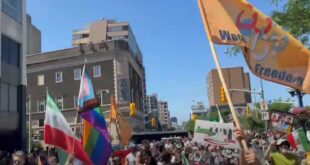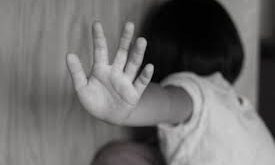Death penalty is premeditated murder by the state. Death penalty allows the killing
of citizens openly and legally by states. This crime committed by the government
depreciates human life and reduces the repellent nature of murder on the one hand,
and, on the other, reflects the dominance and supremacy of the ruling class and the
powerlessness of the citizens. In societies where the capital punishment prevails
infringement on the life and security of the people is easier and more common than
in other societies. Throughout human history dictators have always used capital
punishment as a means of suppression and social intimidation to maintain the
dominance of the ruling classes. From this perspective capital punishment, even
the execution of criminals is a political crime.
The Islamic regime is among the governments that make ample use of capital
punishment. In addition to prison and torture and retribution and flogging and
assassination, it also makes use of this weapon extensively, verging on genocide, in
order to push back and suppress a rebellious society that detests it. If capital
punishment is a crime, then in Iran it is a hundred times more so because under the
sway of the Islamic Republic it is not only political opponents and people who
have not committed any crime whatsoever who are targeted, but even the execution
sentences for ordinary criminals are entirely unwarranted and murderous. Cases of
executions in Iran would be declared invalid and unjust according to the most basic
modern legal and juridical standards in any court of law.
The ways of executions in the Islamic Republic are also savage and murderous.
Public executions, including hanging from a crane, throwing the condemned down
from a height, as is used for homosexuals, execution by stoning that was stopped
due to widespread protests, and involving the family of the murder victim in
deciding the verdict and carrying out the execution, are all current methods of
executions and indications of the infinite savagery of the Islamic Republic.
It is therefore far from an exaggeration to say that nowhere in the world is the
savagery and cruelty of capital punishment more apparent than in the Islamic
Republic. Executions in Iran are the instrument of genocide, Ideological cleansing,
disposing of political opponents, imposition of religious laws and creating fear, and
casting the shadow of death over society as a whole in order to maintain a horrific
religious state.
In the summer of 1988 alone more than five thousand political prisoners, mostly
very young men and women of the opposition who were serving their sentence
periods, were secretly executed and buried in mass graves with no trace. These
executions took place by order of the highest authority in the country, Khomeini.
The “Death Committee” implemented by him, of which EbrahimRaiisi, (the
current president of Iran) was also a member, asked only one question from the
prisoner and then gave their sentence. Before this catastrophe, between the years
1981-84, they had engaged in the same genocide, albeit openly and on a larger
scale, through the savage attacks of gangs Hezbollah thugs . Thousands, mainly
very young, went through trials of “revolutionary courts” lasting no more than
several minutes, and were immediately executed, often for distributing leaflets or
writing a slogan on a wall. There were days following May 1981 when daily
newspapers published with long lists of the day’s executed youth, asking the
parents to come and take the bodies. The government even demanded the cost of
the bullets with which the young person was put to death before handing over the
body.
The first action of the government was immediately after coming to power after
1979 revolution was summary executions-without –trial, of the authorities of the
old regime. The new regime then used the terrifying instrument of death penalty
complemented with governmental killings and assassinations, targeting the people
who had made a revolution with the expectation of freedom, welfare, and control
of their own destiny. The field execution of Shir Mohammad Derakhshandeh
Toomaj, AbdulhakimMakhtoom, Tavagh Mohammad Vahedi and Hussein
Georjani, leaders of the councils of the people of Turkemansahra,inFebruari 1980,
the street assassination of Jahangir GhalehMiyandoaab (one of the popular leaders
of the unemployed workers’ movement and shooting into their protest lines in
February 1981),the mass execution of at least 56 people in the cities of Sanandaj,
Saghez, Mariwan, Paweh, and Kermanshah through 1979, where people continued
the revolution through their elected councils, the attack on universities in the whole
country to purge their opponents and communists in the name of “cultural
revolution” and the killing of tens of students by “Hizbullahi” thugs’ are all
manifestations of the efforts of the Islamic Republic to consolidate its rule through
execution, assassination and imprisonment during the first years of its reign. The
pictures published from only one of these crimes, i.e. the execution of a line of
militant youth in Sanandaj airport, including NaserSalimi and Ahsan Nahid, one
with a bandaged hand and the other lying on a stretcher in September 1979,
represent one of the most shocking crimes of contemporary history.
We should also mention the execution of 59 people in the city of Mahabad when
the age of the condemned was below 18. Many of the post revolution executions
were ordered by Khalkhali, according to Islamic Sharia law unceremoniously and
without trial. Khalkhali’s confessions reflect an aspect of the immensity of the
crimes of the Islamic Republic: “I was the Sharia judge and executed over five
hundreds of criminals and the agents of the Shah’s regime and hundreds of the
activists of the unrest in Kurdistan, Gonbad and Khuzestan, and also killed a
number of troublemakers and drug smugglers.”
But this scale of executions and state crimes were still not enough to save the
Islamic Republic. The Islamic regime engaged in full scale genocide, once to
conclusively defeat the 1979 revolution and establish itself as the dominant power,
and the second time to confront the possible consequences of the end of the war
with Iraq—something it had boasted it would continue till victory. The executions
and political killings of the 1980’s are the most obvious instances of crimes against
humanity in contemporary history.
Also after the war, the Islamic regime’s apparatus of executions and assassination
of its opponents and the protesting people has incessantly been in operation until
now. “chain killings” during the presidency of Rafsanjani in 1998 when writers
and political activists such as Mohammad JafarPooyandeh, Mohammad Mokhtari,
ParvizDavani, ParvinEskandari and DaryoushForouhar were strangled or lynched
with knives by the agents of the Information Ministry, organized assassination and
shooting to death tens of opposition members abroad such as ShapoorBakhtyar,
GholamKeshavarz, SedighKamangar, FereydoonFarrokhzad, Abdurrahman
Ghasemlou, KazemRajavi, and SadeghSharafkandi, the killing of tens of people
in the 2009 protests both on the streets such as Neda Aghasultan, or under torture
in prisons such as SattarBeheshti and Zahra Kazemi, or the shocking crimes
carried out in the Kahrizak prison after the 2009 uprising such as the killing of
Mohsen Rouhulamini, Mohammad Kamrani, and Amir Javadifar under torture, the
time by time execution of political prisoners such as FarzadKamangar and his
comrades, RaminHosseinpanahi, Loghman and ZanyarMoradi and Roohullah
Zamand many others, and the “suicides” of condemned political prisoners inside
the prison such as KavousSeyyedEmami, SinaGhanbari, and Zahra Bani
Yaghoub, the massacre of 1500 demonstrators in October 2019 and the execution
of those arrested in the protests of recent years such as the execution of Navid
Afkari’ are all further evidence of the fact that premeditated governmental murder
in Iran is the means of splashing blood on Iranian society for the sake of the
survival of the Islamic regime.
But these executions and murders that been carried out against the political
opposition and the protesting people still fail to reflect the depth of the Islamic
savagery and the inhuman dimensions of capital punishment in Iran. Many of the
victims of governmental killings have been atheists or followers of other religions
such as the Bahaiis, among them Mona Mahmoudnezhad who was hanged at the
age of 17 in Shiraz, and the Darwishes, among them Mohammad Salas who was
executed, or “insulters” of the p rophet. In certain cases capital punishment has
been used for such “crimes” like drinking alcohol. Homosexuals have been
executed for their sexual orientation. There are countless cases of the execution of
children and minors. In many cases execution sentences have been carried out
against women such as Reyhaneh Jabbari who have defended themselves against
sexual molestation of men, in many cases government authorities. Also many
imprisoned girls have been raped before execution, to follow the Sharia order
against the execution of virgins.
The execution of children in the Islamic Republic –such as AtefehRajabi—is a
blatant example of the savagery of this government. The Islamic regime has rightly
been called the executioner of children. This regime has executed many minors
who at the time of their arrest and issuing of the execution verdict were under 18
years of age. To avoid international pressure, the Islamic Republic issues the
execution sentence but executes them after they have reached 18, or, as in the case
of Mehdi Sohrabifar, Amin Sedaghat, and MahboubehMofidi (nicknamed the 17
year old bride) executes them in secret.
But the highest number of executions in Iran is related to cases that according to
some people may be legally justified. The execution of murderers, rapists, the
smugglers and sellers of narcotics, or hoarders has put the Islamic Republic at the
top of the list of countries that practice capital punishment. However, even such
executions have been carried out in the most unfair conditions contrary to the
civilized and modern judiciary standards. Moreover, the government has openly
used these executions as a means to show its power and an iron fist to society as a
whole. The regime has a number of prison inmates at its disposal, who are
condemned to death(usually from the most deprived and defenseless sectors of
society such as Afghani refugees and asylum seekers), and uses them to create
intimidation campaigns by setting up gallows when sees necessary. The Islamic
Republic is in reality what it is called namely “the regime of the one hundred
thousand executions”.
A terrifying aspect of capital punishment in Iran is its being linked to Sharia law
such as the principle of retribution. In cases of murder, the Islamic Republic tries
to include the killed person’s family as “owners of the blood” in the process of
punishment, turning them into accomplices in premeditated state murder.
Iran however, is not only the country of “a regime with one hundred thousand
executions.”. It is also the country of the everyday fight against capital punishment.
In Iran there is a broad mass movement against capital punishment, which, in
recent, thanks to the efforts of the International Committee against execution
reached its zenith. It has now become one of the strongest mass movements in the
country. Within the campaigns of this movement unknown people who were
waiting to be executed such as NazeninFathi, KobraRahmanpour, Afsaneh
Nowroozi, ShahlaJahed, DelaraDarabi, SinaDehghan, and tens others became
internationally known and some of them were saved from execution. Thus a
strong, political, and humane movement with tens of well-known features was
born. This movement comes to the fore on various occasions. Its latest
manifestation was the online march against capital punishment in the world in June
2020, when an 11.000000 strong twitter storm in opposition to the execution
verdict for three of those arrested in October 2020 forced the regime into retreat.
There is also a widespread movement seeking justice against all the regime’s
crimes, in particular the executions of the 1980s , demanding the trial of the heads
of the regime. This movement is quite influential and increasingly gathers
momentum, becoming more widespread with the arrival of mothers who seek
justice. One example is constant presence of Khavaran Mothers who keep the
memory of their lost loved ones, alive. (Khavaran is the name of a remote
cemetery in Tehran, which has become very famous in Iran for burying the bodies
of thousands of political prisoners and has become a gathering place for justiceseeking
people).The Iran Tribunal , putting Hamid Noori on trial in Sweden which
was made possible thanks to the work of political activists and the families, are
other examples of the work of the movement against Islamic regime and capital
punishment. The criminal move of the Islamic regime to involve the families of the
murder victims to engage in execution of their beloved killers, has been faced with
the “forgiveness movement” by the dead person’s relatives and experienced a clear
defeat.
Here we should also point to the international worldwide movement against
stoning, the most savage form of execution by the regime, aiming to intimidate
women and force them into submission. The campaign to save SakineMohammadi
Ashtyani a woman who was convicted to death by stoning, disgraced the Islamic
Republic in the eyes of the world, and forced it to stop the practice of this heinous
crime.
The International Committee against execution asks for the immediate and
unconditional annulment of all execution sentences in Iran. In our view death
penalty is not acceptable under any circumstances. The execution of political and
ideological opponents, execution based on sexual orientation, and the execution of
children should not only be totally stopped, but each such case must be condemned
globally as a crime by the Islamic Republic against humanity. We demand the
formation of fact finding committees in relation to all the executions carried out by
the Islamic Republic. We ask for an immediate end to executions in public, and its
condemnation internationally. The medieval and inhuman law of retribution and
involvement of “the owners of the blood” in deciding the performance of execution
verdicts should be stopped. We are part of the indictment movement in Iran and we
strive for the fulfillment of all its demands, including the trial of the heads of the
Islamic regime of Iran for committing numerous crimes against humanity.
International Committee Against Execution (ICAE)
https://noto-execution.blogspot.com
3rd October, 2021
 روزنه rowzane خبری – تحلیلی
روزنه rowzane خبری – تحلیلی




